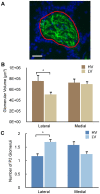Toward a mouse neuroethology in the laboratory environment
- PMID: 20613876
- PMCID: PMC2894054
- DOI: 10.1371/journal.pone.0011359
Toward a mouse neuroethology in the laboratory environment
Abstract
In this report we demonstrate that differences in cage type brought unexpected effects on aggressive behavior and neuroanatomical features of the mouse olfactory bulb. A careful characterization of two cage types, including a comparison of the auditory and temperature environments, coupled with a demonstration that naris occlusion abolishes the neuroanatomical changes, lead us to conclude that a likely important factor mediating the phenotypic changes we find is the olfactory environment of the two cages. We infer that seemingly innocuous changes in cage environment can affect sensory input relevant to mice and elicit profound effects on neural output. Study of the neural mechanisms underlying animal behavior in the laboratory environment should be broadened to include neuroethological approaches to examine how the laboratory environment (beyond animal well-being and enrichment) influences neural systems and behavior.
Conflict of interest statement
Figures




References
-
- Polley DB, Kvasnak E, Frostig RD. Naturalistic experience transforms sensory maps in the adult cortex of caged animals. Nature. 2004;429:67–71. - PubMed
-
- Castelhano-Carlos MJ, Baumans V. The impact of light, noise, cage cleaning and in-house transport on welfare and stress of laboratory rats. Lab Anim. 2009;43:311–327. - PubMed
-
- Gonder JC, Laber K. A renewed look at laboratory rodent housing and management. ILAR J. 2007;48:29–36. - PubMed
-
- Mandairon N, Stack C, Kiselycznyk C, Linster C. Enrichment to odors improves olfactory discrimination in adult rats. Behav Neurosci. 2006;120:173–179. - PubMed
-
- Lewejohann L, Reinhard C, Schrewe A, Brandewiede J, Haemisch A, et al. Environmental bias? Effects of housing conditions, laboratory environment and experimenter on behavioral tests. Genes Brain Behav. 2006;5:64–72. - PubMed
Publication types
MeSH terms
Grants and funding
LinkOut - more resources
Full Text Sources

